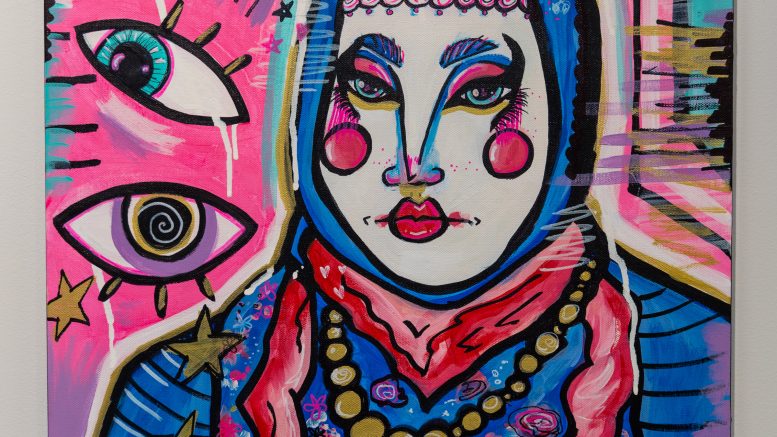Pride month may be over, but a new exhibition of 2SLGBTQIA+ art has begun at aceartinc.
Curated by James Turowski, QUEERiosities: A Queerious Art Exhibition opened on July 5 and showcases the work of 20 local artists. The exhibition’s theme is magic and art — the aspects of life represented by the turquoise stripe of the original 1978 rainbow flag design. The displayed works encompass a wide range of media from painting and photography to ceramics and textiles.
Faced with the challenge of how to organize such a diverse array of pieces, Turowski said that he tried to “pick works that work well together […] as a unit on a wall where they’ll flow nicely with colours or shapes or styles.” The variety of pieces was meant to provide “a nice overview of what’s being made right now in the queer arts scene in Winnipeg and Manitoba.”
QUEERiosities is the ninth edition of the annual Queerious art show, which Turowski took over as curator in 2019.
“To be queer is to be on the outside and […] a little bit weird, a little bit creative, a little bit different than the norm,” he said, adding that art can be “a great way of processing […] that outsider feeling.”
This comment resonated with the experience of my own queerness. In years past, my self-understanding was shaped by doubt, shame and fear far more than anything to do with euphoria or self-love. Perhaps this explains my preference for dark, absurd and vulgar depictions of queer identity over brighter and more joyous works.
Finn Swanson-Bilyk’s exhibited piece “Wash Your Hands” — a riff on Marcel Duchamp’s iconic “Fountain” — is a fine example of this absurd vulgarity. Like “Fountain,” “Wash Your Hands” depicts a defaced urinal. Instead of the artist’s signature, however, Swanson-Bilyk littered her ceramic canvas with a plethora of graffiti, including a middle finger, a urinating devil, the words “CALL YOUR MOM” and seemingly a penis and testicles.
Along similar lines, Max Blue’s “Comfort Play” acts as a counterbalance to the mainstream sanitization of queer sexual life. The piece — a headless, limbless mannequin clothed in blue fabric — is wrapped in a bondage harness, covered in patches containing risqué phrases and has a pair of clothespins where the nipples would be on a human torso.
Blue described the piece as an “exploration into kink and fantasy” and a promotion of “finding comfort in turning your brain off and experiencing pleasure.” Emphasizing the patch labelled “T4T,” he added that “I feel I can fully be myself with other trans people and not have [gender] dysphoria come into play.”
An abbreviation of “trans for trans,” the slang term “T4T” refers to trans people who seek out companionship and sexual encounters with fellow trans people.
Likewise, the joy of discovering community based on shared identity is the theme of Ally Gonzalo’s photo collage “Sama-sama,” named after the Tagalog word for “altogether.” In preparing the piece, they took pictures of 44 queer Filipinx people and allies, although only 42 appear in the finished product. The other two had not come out and did not consent to being included in the work.
Gonzalo intended the piece to highlight diversity within the community. “Just because the Filipino population here […] does tend to be [queerphobic], it doesn’t have to be,” they said.
As of the 2021 census, Winnipeg is home to a Filipinx population of around 80,000 people. To truly represent the significance of the community, Gonzalo remarked that they would have preferred to print a larger version of the collage — “even life-size, if it’s possible” — but faced budget constraints due to the cost of printing and production. Fortunately, funding from Bahaghari Pride Manitoba allowed them to complete the project.
“Look at us,” Gonzalo said. “This is how beautiful the community is, and whether you like it or not, we’re not going anywhere!”
The invitation to look may well have been directed at the floating disembodied eyes on the opposite wall, which belonged to a surrealist Jude Yallowega painting titled “Baba Yaga.”
In addition to being a painter, Yallowega is a drag queen who performs under the name Miss Gender. “Baba Yaga” is a self-portrait based on a drag look he adopted on multiple occasions. Inspired by the Russian folklore character of the same name, Yallowega says he was fascinated by the description of Baba Yaga in feminist texts as a “phallic mother.”
“I take a lot of power in presenting myself both […] in a gender-fucked way as well as […] the beneficiary of her whims and magic,” he explained. The character “has a very significant place in my heart as someone who was raised a girl [and] had girlhood imposed onto him.”
By contrast, Yallowega’s other piece in the exhibition, a mixed-media painting named “Yellow Guy #4,” is more abstract in the representation of its subject. Although he finds it “easy” to envision himself in a drag persona, “when I’m trying to portray myself as […] a gender-non-conforming trans man, I really falter with the details. […] I’m just a little yellow guy.”
QUEERiosities: A Queerious Art Exhibition runs at aceartinc. (206 Princess Street) until August 3, 2024. Gallery hours are Wednesday through Saturday from 12 p.m. to 5 p.m.


